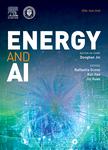Correlation between microstructures and macroscopic properties of nickel/ yttria-stabilized zirconia (Ni-YSZ) anodes: Meso-scale modeling and deep learning with convolutional neural networks
作者机构:School of ScienceHarbin Institute of TechnologyShenzhen518055China Institute of Industrial ScienceThe University of TokyoTokyo153-8505Japan Department of Mechanical EngineeringFaculty of EngineeringChiba Institute of TechnologyChiba275-0016Japan
出 版 物:《能源与人工智能(英文)》 (Energy and AI)
年 卷 期:2022年第7卷第1期
页 面:31-42页
核心收录:
学科分类:0820[工学-石油与天然气工程] 0808[工学-电气工程] 08[工学] 0812[工学-计算机科学与技术(可授工学、理学学位)]
基 金:This work was supported by the National Natural Science Foundation of China(Nos.11932005,12172104) the National Key R&D Program of China(No.2018YFB1502602) Shenzhen Science and Technology Innovation Commission(JCYJ20200109113439837)
主 题:Solid oxide fuel cells Porous microstructure Anode Effective macroscopic properties Convolutional neural network
摘 要:A deep learning based homogenization framework is proposed to link the microstructures of porous nickel/yttriastabilized zirconia anodes in solid oxide fuel cells(SOFCs)to their effective macroscopic properties.A variety of microstructures are generated by the discrete element method and the meso‑scale kinetic Monte Carlo ***,the finite element method and the homogenization theory are used to calculate the effective elastic modulus(E),Poisson’s ratio(υ),shear modulus(G)and coefficient of thermal expansion(CTE)of representative volume *** addition,the triple-phase boundary length density(LTPB)is also *** convolutional neural network(CNN)based deep learning model is trained to find the potential relationship between the microstructures and the five effective macroscopic *** comparison between the ground truth and the predicted values of the new samples proves that the CNN model has an excellent predictive *** indicates that the CNN model could be used as an effective alternative to numerical simulations and homogenization because of its accurate and rapid prediction *** the deep learning-based homogenization framework could potentially accelerate the continuum modeling of SOFCs for microstructure optimization.



